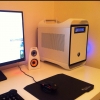-
Posts
109 -
Joined
-
Last visited
Awards
This user doesn't have any awards
About TJStamp
- Birthday May 26, 1987
Contact Methods
-
Twitter
TJStamp
Profile Information
-
Gender
Male
-
Location
London, UK
-
Interests
Virtualization, Internet Security, Storage, Photography, Technology, Gaming, IoT
-
Biography
Datacentre Rackmonkey, storage and virtualization specialist
-
Occupation
Datacentre Engineering and Architecture
System
-
CPU
Intel Core i7 3770K @4.8 GHz
-
Motherboard
Asus P8Z77-I Deluxe
-
RAM
16 GB DDR3 1866 MHz
-
GPU
EVGA Nvidia GTX 670 FTW S2
-
Case
BitFenix Prodigy White
-
Storage
2x RAID-0 256 GB SSDs + 2x RAID-1 2TB HDDs
-
PSU
Silverstone Strider 500W
-
Cooling
Corsair Hydro H100
-
Mouse
MadCatz R.A.T. 5
-
Operating System
Windows 8.1
Recent Profile Visitors
1,043 profile views
TJStamp's Achievements
-
Stop the windows update service, rename the C:\Windows\SoftwareDistribution folder to something like "SDOLD" and then start the windows update service again. This tends to fix about 75% of all windows update problems
-
the kingston SSDNow v300 does NOT perform well... at all... you can save at least £20 on the power supply there to put towards a better or bigger SSD, the v300 series are an absolute joke though, the low cost is a completely false economy
-

good idea to disbale 2 cores on fx 9590
TJStamp replied to Bajantechnician's topic in CPUs, Motherboards, and Memory
The only way to get my 8320 into reasonable temps with a coolermaster Seidon 120 aio cooler was to undervolt it... I tried lots of different things like turning off cores and reducing the clock speeds but the most significant improvement was definitely dropping the voltage. There was no perceivable power or temperature difference when disabling cores, reducing clocks helped a little but not enough. After a lot of experimentation I got the system to run perfectly at stock speeds on all 8 cores at 1.21v and it was almost 20c cooler while reducing the power draw at the wall by almost 60watts. Most boards bios/uefi allow you to undervolt the northbridge too which can help. obviously not all chips will undervolt to the same degree, just takes a bit of trial and error to find a clock/voltage combination which works for you -

CPU broken? G3258 stuttering all the time
TJStamp replied to ISOlated's topic in CPUs, Motherboards, and Memory
As you're taking about a couple of seconds of full system hitching even when not under load it really doesn't sound like it's a windows issue. Have you tried manually resetting the bios/efi to factory settings?- 32 replies
-
- overclocking;
- cpu;
-
(and 4 more)
Tagged with:
-

CPU broken? G3258 stuttering all the time
TJStamp replied to ISOlated's topic in CPUs, Motherboards, and Memory
just run msconfig and ccleaner and go through the startup items and background services from time to time ... keeping windows as fresh as (or better than) new is incredibly easy, just takes a little knowledge and a little time- 32 replies
-
- overclocking;
- cpu;
-
(and 4 more)
Tagged with:
-

CPU broken? G3258 stuttering all the time
TJStamp replied to ISOlated's topic in CPUs, Motherboards, and Memory
Single threaded performance on haswell is excellent, 2 cores is more than enough for most games, the vast majority of which still don't take any advantage of multi-core setups. Having 2 cores instead of 4 would only result in lower fps and isn't likely to be a cause of semi-regular stuttering in gameplay which the OP claims is otherwise smooth. Can you run HWMonitor and find out what the min/avg/max temps are while gaming on the 3258 and the 960? Also check that when you reset the overclock back to normal that the memory timings defaulted back too ... restoring BIOS/EFI to factory default would be a good first step- 32 replies
-
- overclocking;
- cpu;
-
(and 4 more)
Tagged with:
-

CPU broken? G3258 stuttering all the time
TJStamp replied to ISOlated's topic in CPUs, Motherboards, and Memory
The pentium 3258 anniversary edition is still a haswell core CPU... same architecture as the i3 i5 and i7 chips of that generation... your assertion is completely incorrect.- 32 replies
-
- overclocking;
- cpu;
-
(and 4 more)
Tagged with:
-

7 Gamers, 1 CPU - Ultimate Virtualized Gaming Build Log
TJStamp replied to LinusTech's topic in LTT Releases
A great video, probably one of my faves! I have been using virtualized desktops on a single host machine for the last few years now and have always wondered why there's no big adoption of the process... Using one rig as firewall, iSCSI SAN, media NAS, Windows Server, and two windows home theatre PCs with dedicated GPUs saves a ton of power and space. i guess it's just not widely known about... still can't figure out why you'd use unraid though with free better supported options like Xen around which have better baremetal performance and lighter weight hypervisors. even vmware esxi would have been a credible alternative -
hunting through my spares pile I've only got G7's and G9's handy so can't be completely sure. The G6 series is end of life and out of warrantee, which makes them pretty cheap to buy at least. All the DL380 ranges use onboard SAS headers instead of SATA ports so trying to internally mount any drives would be a challenge, from memory I'm pretty sure the G6 has 2 LSI SAS controllers onboard, both connected to the drive bays via backplane. To add any more storage then you would need another storage controller card as the max onboard is 8 drives. Incidentally you can take out the plastic blanks at the front and add another 8x 2.5" drive bays if you add more internal storage controllers DL380s make great storage servers or VMWare Host machines EDIT: just saw second question, all our 380's have included PCI-e risers out of the box, there are several kinds though, that ebay link claims to be the full spec riser "Riser Board with 6x PCIe (4-x4) (2-x4)"
-
stock 980... on purpose?
-
the power consumption of the g6 proliant range is insane, hope someone else is paying the power bills, does save on heating in the winter though
-

Windows 7: windows 7 update stuck at "checking for updates..."
TJStamp replied to Dunzaus's topic in Troubleshooting
I find that most of the time a complete reset of the update system is the best fix. in a command prompt enter the following lines one after the other... net stop wuauservnet stop wuauservdel c:\windows\SoftwareDistribution\ /q /sdel c:\windows\WindowsUpdate.lognet Start BITSnet start wuauserv This will stop the update service, completely clear it's database, empty the log and then start it again. -
cpu, RAM and HDD are all poor choices IMO
-
why not change the router NIC for a better one? QuadPort PCI-E gigabit NICs are really very cheap these days on ebay
-
if possible each 2950 should be directly connected to the router, if you chain them like that there will be a huge bottleneck on the link between switch2 and the router






